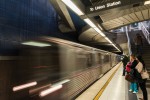Los Angeles’ public transportation system, like any city’s transportation network, is large, complex and sometimes slow. But it needs to pick up the pace when it comes to addressing the safety concerns of its riders.
LA Metro could be the second-most extensive public transportation system in the United States by 2028. In 2016, Angelenos overwhelmingly approved Measure M, which will haul in about $860 million annually for LA to alleviate traffic congestion, expand rail lines, fix potholes and improve roads, while also creating more than 460,000 new jobs.
But there’s been a steady decline in Metro’s ridership. In 2017, roughly 400 million trips were taken using Los Angeles County public transportation, as reported by Metro – a 15 percent decrease over the past five years. This drastic drop has a rippling effect: An ever-increasing population that is dependent on personal car use causes significant traffic, pollution, health and parking problems throughout the city.
A third of the frequent riders who abandoned public transit in 2016 said safety concerns were a primary reason for the change, according to a recent Metro survey. Of course, safety problems are endemic to any crowded and compact public space, but Metro still has a responsibility to develop a culture of safety that discourages instances of harassment while encouraging riders to report incidents they see or experience. Informing riders of Metro’s security measures, creating online outlets for riders to report instances and regularly soliciting user feedback could improve Angelenos’ feelings of safety when they ride Metro.
This isn’t to say Metro hasn’t taken active measures to improve safety. Just last year, Metro approved a $797 million security plan that requires the LA and Long Beach police departments and the LA County Sheriff’s Department to station officers at their respective transit stops. Metro has also installed countless security cameras and a 24/7 sexual harassment counseling hotline. Within the first year of this program, its rate of sexual harassment cases dropped 7 percent.
But these measures still are not enough to ensure a safe environment for all passengers. Many riders still feel unsafe while using public transportation in Los Angeles. A 2011 study by the Urban Institute about the use of security cameras for crime control and prevention in urban environments found that the number and location of these cameras, as well as how well those camera feeds are monitored, play a significant role in their ability to reduce crime. Although there are hundreds of security monitors throughout the Metro system, there must be a perception that a diligent security figure behind those cameras is ready to aid them if the need arises – something that isn’t readily apparent as of now.
From the policy perspective, these sexual harassment incidents affect equal access to necessary public services, which could play a role in Metro’s declining ridership. The fact that ridership is declining in spite of Metro’s various services could mean riders are either unaware of these changes or Metro does not go far enough to ensure a safe travel environment.
Metro must make reporting instances of harassment to the proper authorities as easy and smooth as possible. New York City’s Metro instituted an online system for reporting all incidents of harassment and allows riders to text their complaints to the New York City Metro. LA Metro introducing a mobile app would allow for more real-time reporting of incidents that include their time, date, location and description – something LA Metro’s hotline may not easily capture.
LA Metro should also provide easier methods for users to submit feedback about their rider experiences. Airports worldwide have incorporated use of the HappyOrNot system that allows fliers to simply press a button to let the airport staff know what passengers think about various aspects of customer service at the airport. Although this method is simplistic and subject to inaccuracies, providing a method of simple communication at every exit of every rail stop or bus can shed some light on riders’ experiences. Metro currently surveys riders via phone calls, paper surveys and focus groups. These are valuable methods but soliciting more feedback in real-time would allow administrators to collect data on the day-to-day experience of riders, rather than a summary of their overall rider experience.
Of course, these reforms will take time. The traffic situation in Los Angeles will only become more dire as the population grows and more people ebb away from using Metro. But that is precisely why Metro must experiment with different methods of bringing riders back into its services. It should enact simple communications and data collection reforms to improve safety, reliability and accessibility if it wants to compete against Uber, Lyft and other traveling services.
In a way, Metro is like a business, and businesses thrive when they listen to their customers’ demands. Through careful study and a willingness to try new things, Metro could connect America’s driving city like never before.
